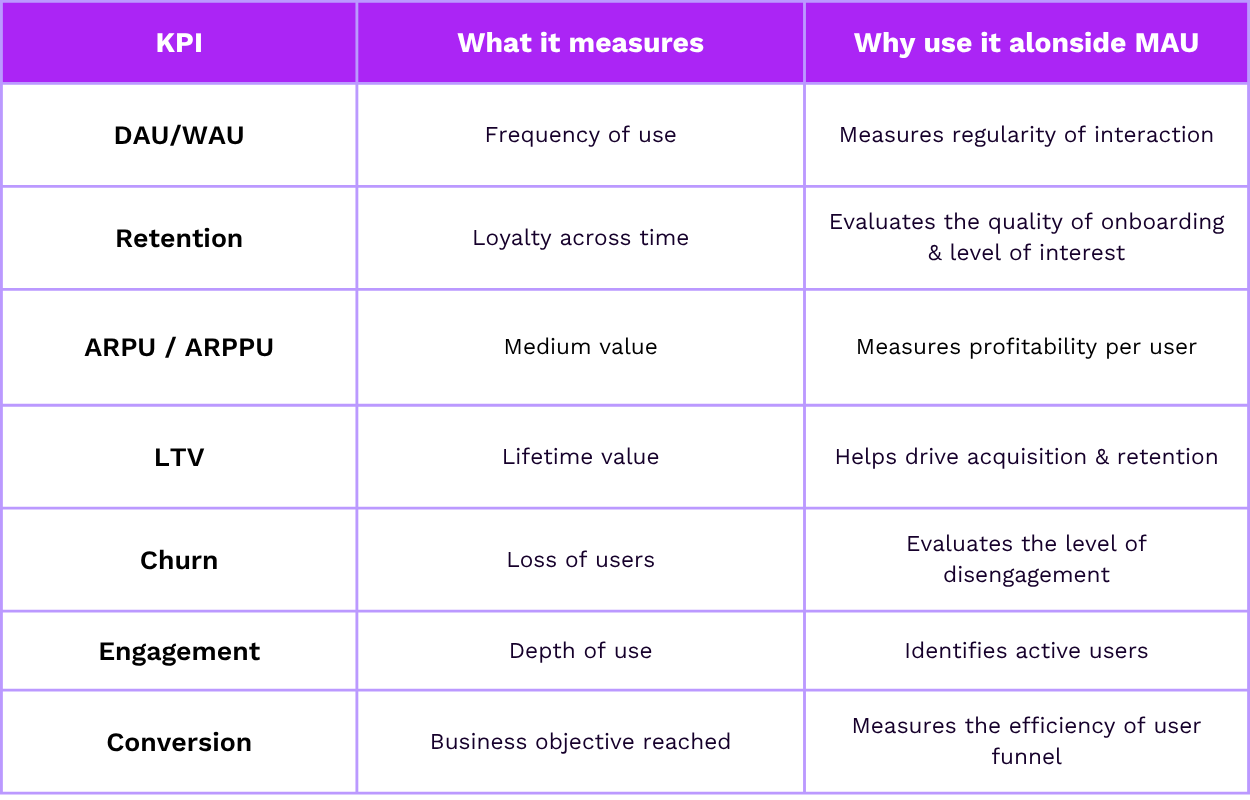Introduction
In mobile marketing, some indicators consistently come up when evaluating an app’s performance. The Monthly Active Users (MAU) metric is one of the most frequently used KPIs to assess how engaged a user base truly is. It reveals how many people actively use an app over a given period, beyond the mere number of installs. But how is MAU defined, measured, and more importantly, interpreted? On this page, we break down what MAU means, how to use it smartly, and which best practices can help drive it in the right direction.
What is a Monthly Active User?
A Monthly Active User (MAU) refers to a unique user who has engaged meaningfully with an app or service at least once during a 30-day period. This interaction can take various forms depending on the criteria defined by the company: opening the app, viewing content, adding items to a cart, completing a purchase, or any other relevant action.
It’s important to note that each user is counted only once per month, even if they perform multiple actions or log in several times. The goal is to measure the actual reach of engagement—not the frequency of use, which is typically tracked with DAU or WAU.

How Are Monthly Active Users Measured?
MAU measurement relies on three pillars: the user, the action, and the timeline.
User, Action, Timeline: the Three MAU Pillars
To be counted as a Monthly Active User (MAU), three criteria must be met:
- the user must be uniquely identified,
- must perform a defined “active” action,
- within a 30-day period.
These three elements are essential for maintaining consistency and reliability of the KPI.
- The User – A Unique Identification: A “user” is not simply a device or a click. It’s an individual uniquely identified within the app ecosystem. This identification can be done through:
- a user account (email, login)
- a device ID (IDFA, GAID…)
- an internal client ID generated in the database
👉 Why is this important?
It prevents counting the same user multiple times if they interact across channels or devices. The objective is to de-duplicate sessions and count only unique users.
- Defining What Counts as Activity: Just installing an app does not qualify as being active. The user must perform an action defined as “active”, which can vary based on the type of app. Some common examples include:
- Opening the app
- Viewing content or a key page
- Adding to cart or completing a purchase
- Completing a level (for gaming apps)
- Using a core feature (scanner, payment, etc.)
👉 Why is this important?
The action you define determines how meaningful your MAU metric is. A too-low threshold (e.g., simply opening the app) can overinflate the KPI, while too strict a threshold may underrepresent engagement.
- Timeline – A 30-Day Rolling Period: MAU is measured over a rolling 30-day period or a fixed calendar month (e.g., from July 1 to July 31). Only actions performed during this period are considered.
👉 Why is this important?
It helps monitor monthly activity trends and enables month-over-month comparisons. It also helps smooth out seasonal or event-related spikes.
MAU Calculation Method
The MAU is calculated by counting the number of unique users who performed at least one qualifying action during the defined period. For example, if a user logs in 10 times in one month, they are still counted only once.
Analytics tools like Firebase, Amplitude ou Mixpanel can automate this tracking by applying filters to user events.
Why Is Monthly Active User an Important KPI in App Marketing?
Indicator of Product Adoption
MAU shows whether the app continues to be used after the initial download. It reflects how successfully an app integrates into users’ habits over time.
Measure of Engagement
Although Monthly Active User doesn’t detail user behavior, it does indicate general retention and usage regularity. A steadily growing MAU suggests increasing adoption.
Key Metric for Investors
In fundraising or valuation phases, MAU is one of the most closely examined KPIs. It shows both product traction and the size of the engaged audience.
Foundation for Other Metrics
The volume of Monthly Active Users forms the basis for other calculations like ARPU (Average Revenue Per User), churn rate, and monthly retention. It’s a starting point for performance analysis.
MAU vs. WAU vs. DAU: What’s the Difference and When to Use Each?
Active user KPIs can be tracked at different frequencies:
- DAU (Daily Active Users): Ideal for apps used daily (e.g., social media, games, messaging apps).
- WAU (Weekly Active Users): Best for apps used multiple times per week (e.g., productivity tools, e-learning apps).
- MAU (Monthly Active Users): Suitable for apps with more occasional use (e.g., finance, e-commerce, travel).
👉 The best KPI to use depends on your app’s natural usage frequency. Choosing the wrong one can lead to misguided decisions.
Best Practices to Increase Monthly Active Users
- Push Notifications: Well-targeted push messages can remind users about your app, highlight new features or promotions. Personalization is key to avoid being seen as intrusive.
- In-App Messages: These guide users through their journey, encourage the discovery of new features, and promote more frequent usage.
- Email / SMS: These channels remain very effective for re-engaging inactive users or reminding them of unfinished actions (abandoned cart, updates, etc.).
- Deep Linking: Deep links direct users to a specific section within the app, improving the user experience and increasing engagement.
What Are the Challenges of MAU?
- Lack of Industry Standards: There’s no universal definition of a MAU. Each company may define “active” differently, making comparisons between apps tricky.
- Not Ideal for Early-Stage Apps: During launch, data is often unstable, and user bases are small. MAU can give a misleading impression of failure or success.
- Limited Behavioral Insight: Monthly Active User doesn’t reveal what users actually do in the app. It must be combined with behavioral KPIs (session length, conversion paths, etc.).
- No Qualitative Measurement: MAU doesn’t differentiate between highly engaged and casual users. An active user isn’t necessarily a profitable one.
- Risk of Double Counting: If a user accesses the app on multiple devices without unified tracking, they may be counted more than once.
- Event or Seasonal Bias: A spike in Monthly Active Users may be due to a temporary campaign or event. It’s important to analyze such spikes in context.

Do not hesitate to contact with our teams
Addict can support you to improve your performance.
Complementary KPIs to Master
DAU / WAU (Daily / Weekly Active Users)
These metrics help track usage frequency. By comparing DAU to MAU, you can calculate the DAU/MAU ratio, also known as the stickiness rate.
➕ Derived KPI:
DAU/MAU = Loyalty or Recurrence Rate
Example: A DAU/MAU of 0.2 means the average user opens the app ~6 days per month.
Retention Rate (Day 1, Day 7, Day 30…)
Monthly Active Users tells you how many people use the app in a month, but not how many return after their first session. Retention measures your ability to keep users active over time.
Example: An app may have a high MAU but poor retention if it acquires lots of users but loses them quickly.
ARPU / ARPPU (Average Revenue Per User / Paying User)
MAU doesn’t reflect user quality or monetization. ARPU shows the average revenue generated per active user.
A growing MAU without ARPU increase may suggest that new users are less monetizable.
LTV (Lifetime Value)
LTV measures the total value a user generates over their lifecycle in the app. It’s a long-term indicator critical for budgeting and acquisition decisions.
LTV + MAU = Understanding whether volume growth is also value growth.
Churn Rate
MAU doesn’t differentiate new users from lost ones. Churn tells you how many users stop using your app monthly.
Tracking churn helps identify UX or value perception issues.
User Engagement (Sessions, Duration, Events)
MAU says nothing about what users do inside the app. Analyzing User engagement helps you track:
- Number of sessions per user
- Average session duration
- Key events triggered
This reveals which segments are truly active, engaged, or just passive.
Conversion Rate (Sign-up, Purchase, Subscription…)
A high MAU is only valuable if a share of those users achieve your business goals.
Conversion rate measures the effectiveness of user journeys.
Summary:

Conclusion
Monthly Active Users is a core indicator for any app aiming to track growth and user adoption. Easy to monitor and communicate, it provides a global view of monthly engagement. However, it must be complemented by qualitative, retention, and revenue-based metrics to truly assess app health. By combining smart marketing levers (push, emails, deep links…) with detailed behavioral analysis, you can sustainably grow your MAU—and with it, your app’s overall performance.



